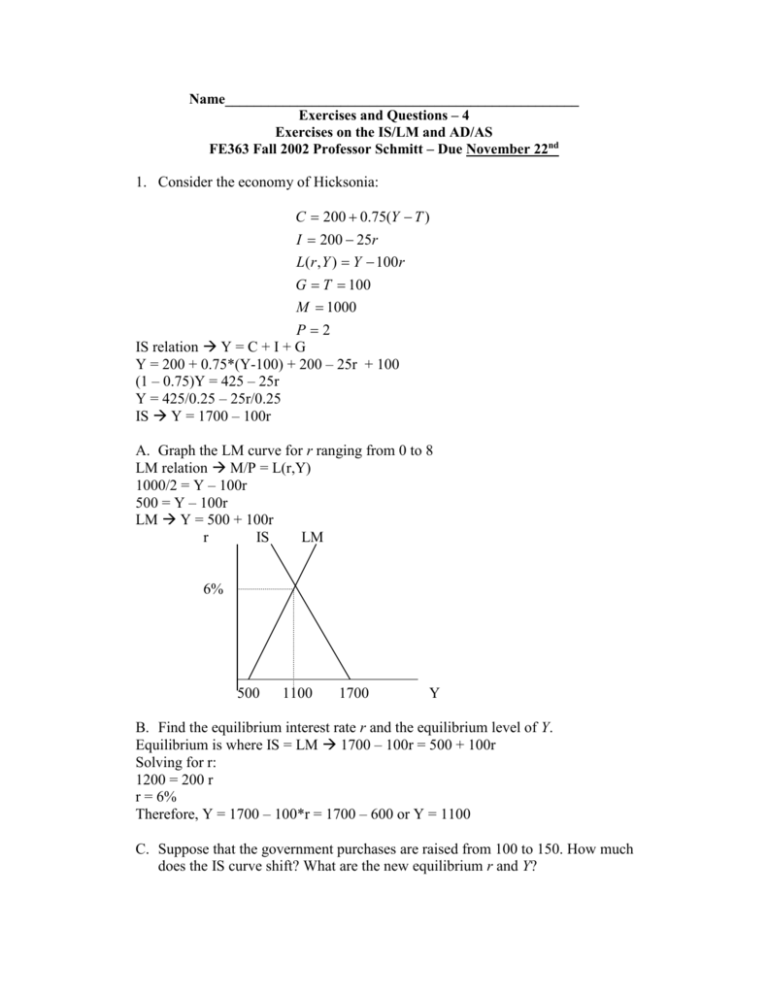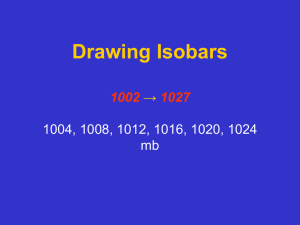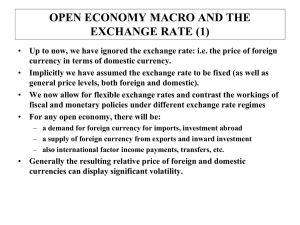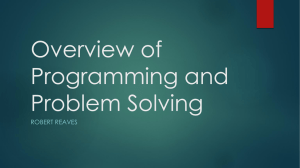Answers to Homework 4
advertisement

Name_________________________________________________ Exercises and Questions – 4 Exercises on the IS/LM and AD/AS FE363 Fall 2002 Professor Schmitt – Due November 22nd 1. Consider the economy of Hicksonia: C 200 0.75(Y T ) I 200 25r L(r , Y ) Y 100r G T 100 M 1000 P2 IS relation Y = C + I + G Y = 200 + 0.75*(Y-100) + 200 – 25r + 100 (1 – 0.75)Y = 425 – 25r Y = 425/0.25 – 25r/0.25 IS Y = 1700 – 100r A. Graph the LM curve for r ranging from 0 to 8 LM relation M/P = L(r,Y) 1000/2 = Y – 100r 500 = Y – 100r LM Y = 500 + 100r r IS LM 6% 500 1100 1700 Y B. Find the equilibrium interest rate r and the equilibrium level of Y. Equilibrium is where IS = LM 1700 – 100r = 500 + 100r Solving for r: 1200 = 200 r r = 6% Therefore, Y = 1700 – 100*r = 1700 – 600 or Y = 1100 C. Suppose that the government purchases are raised from 100 to 150. How much does the IS curve shift? What are the new equilibrium r and Y? If G to 150 Y = C + I + G so Y = 200 + 0.75(Y-100) + 200 – 25r + 150 Y = 1900 – 100r Note you could also have determined that G = 50 so Y = (1/(1-mpc))*G = 4*50 = 200 r IS1 IS2 LM 7% 6% 500 1100 1700 Y 1200 To find the equilibrium set the IS relation = LM relation 1900 – 100r = 500 + 100r 1400 = 200r r = 7% Y = 1900 – 100*r = 1200 D. With the initial value for fiscal policy (G =100), suppose the price level rises from 2 to 4. What happens? What are the new equilibrium interest rate and level of income? This will change real money balances LM relation M/P = L(r,Y) 1000/4 = Y – 100r 250 = Y – 100r LM Y = 250 + 100r r IS LM2 LM1 7.25% 6% 250 500 1100 1700 975 r = 7.25% and Y = 975 (follow same math steps) Y E. Derive and graph an equation for the aggregate demand curve. What happens to this aggregate demand curve with the fiscal policy mentioned in part D? AD is the relationship between the price level and the level of income. Therefore we need to substitute out for the interest rate. To do this solve for the the IS and LM for the interest rate: IS: Y =1,700 – 100r LM: M/P = Y – 100r Price Levels So we can solve for 100r: IS 100r = 1,700 – Y LM 100r = Y – M/P Setting these equal: 1,700 – Y = Y – M/P 2Y = 1700 + M/P Y = 850 + M/2P AD = 850+500/P Y – output Since M = 1000 this is Y = 850 + 500/P I derived AD for part D. If I derived for parts A and B then the increase in G would shift AD to the right. 2. In a small open economy – if a domestic country does not want to change net exports, but wants to stimulate their economy, according to the Mundell-Fleming model, what combinations of monetary and fiscal policy should you pursue? Hint: You will need to make a few assumptions to answer this question – state them clearly. Illustrate with a graph. To keep NX constant and increase Y, a 1) small open economy, with 2) perfect capital mobility, and with 3) fixed exchange rates (“pegging”) Needs to engage in expansionary fiscal policy. r LM1 LM2 r*1 (1) IS1 Y1 G or T IS1 IS2 This puts upward pressure on r . As r > r* capital flows in and e Peg 100Y/$1 pressure to 150Y/$1 Y2 IS2 Y market is selling Yen and buying dollars Fed sells dollars and buys yen. Fed sells domestic currency and sells foreign currency. M (M/P) LM1 LM2 (M/P) r and removes incentives for capital flow. Result: Under a fixed exchange rate, fiscal expansion is effective in Y under perfect capital mobility. 3. Suppose you wanted to make domestic industries more competitive, but did not want to alter aggregate income. According to the Mundell-Fleming model, what combinations of monetary and fiscal policy should you pursue – and what assumptions do you have to make regarding exchange rates? To decrease M and/or increase X (making domestic industry more competitive) – NX would while keeping constant Y, a 1) small open economy, with 2) perfect capital mobility, and with 3) floating exchange rates Needs to engage in contractionar fiscal policy. 4. Using the following data, interpret the situation on an IS-LM curve. One clear thing during this time period, the great depression, is that C fell (arguably due to the stock market crash and consumer confidence) and also I fell (arguably due to decreased housing needs of immigrants). A. Graph the IS/LM model with the fall in C and I. r IS2 IS1 LM r1 r2 Y2 Y1 B. State the Fiscal and/or Monetary Policy changes – and show on the previous graph the shift in IS and/or LM. Focus specifically on the policy changes from 1931 to 1993 ONLY. In 1931 to 1933 – there was fiscal AND monetary contraction: G and M r IS2 IS1 LM2 LM1 r1 Y2 Y1 Expect interest rates to return, but output to fall even further than in A. C. Do the data match your predictions for short-run changes in unemployment, income, and interest rates? Predict that with Y U and r return to 1931 rates This is true for Y and U, but r does not return, in fact r further! D. Did either policy help the recession? Nope – may have had it extend E. If the policies implemented in 1931 – 1933 continued in the same direction – would the economy ever recover – or did recovery only occur due to the Fiscal and/or Monetary Policies implemented after 1933? Can’t say for sure – in the long-run we should see that U causes price levels to fall (as workers will now work for less). This does happen to some degree – which should increase the SRAS and increase the LM… Year GDPR 1929 1930 1931 1932 1933 1934 1935 1936 1937 1938 1939 1940 UR C I G RB M1 P(58$) Real GDP Unemp rate Consumption Investment Government Purchases Interest rates Money supply Price level 203.6 183.5 169.5 144.2 141.5 154.3 169.5 193.2 203.2 192.9 209.4 227.2 3.2 8.9 16.3 24.1 25.2 22.0 20.3 17.0 14.3 19.1 17.2 14.6 139.6 130.4 126.1 114.8 112.8 118.1 125.5 138.4 143.1 140.2 148.2 155.7 40.4 27.4 16.8 4.7 5.3 9.4 18.0 24.0 29.9 17.0 24.7 33.0 22.0 24.3 25.4 24.2 23.3 26.6 27.0 31.8 30.8 33.9 35.2 36.4 5.9 3.6 2.6 2.7 1.7 1.0 0.8 0.8 0.9 0.8 0.6 0.6 26.6 25.8 24.1 21.1 19.9 21.9 25.9 29.6 30.9 30.5 34.2 39.7 50.6 49.3 44.8 40.2 39.3 42.2 42.6 42.7 44.5 43.9 43.2 43.9









